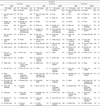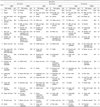1. Wolfson JA, Bleich SN. Is cooking at home associated with better diet quality or weight-loss intention? Public Health Nutr. 2015; 18:1397–1406.

2. Oh C, Kim HS, No JK. Impact of dining out on nutritional intake and metabolic syndrome risk factors: data from the 2011 Korean National Health and Nutrition Examination Survey. Br J Nutr. 2015; 113:473–478.

3. Zick CD, Stevens RB. Trends in Americans' food-related time use:1975-2006. Public Health Nutr. 2010; 13:1064–1072.
4. Lee HJ. Golden age of low-cost, upscale, or home-made packaged meals in time when picnics are popular. Hankyung Bus. 2012; 860:49–51.
5. Smith LP, Ng SW, Popkin BM. Trends in US home food preparation and consumption: analysis of national nutrition surveys and time use studies from 1965-1966 to 2007-2008. Nutr J. 2013; 12:45.

6. Powell LM, Nguyen BT. Fast-food and full-service restaurant consumption among children and adolescents: effect on energy, beverage, and nutrient intake. JAMA Pediatr. 2013; 167:14–20.

7. Mancino L, Todd J, Lin BH. Separating what we eat from where: measuring the effect of food away from home on diet quality. Food Policy. 2009; 34:557–562.

8. Orfanos P, Naska A, Trichopoulos D, Slimani N, Ferrari P, van Bakel M, Deharveng G, Overvad K, Tjønneland A, Halkjaer J, Santucci de Magistris M, Tumino R, Pala V, Sacerdote C, Masala G, Skeie G, Engeset D, Lund E, Jakszyn P, Barricarte A, Chirlaque MD, Martinez-Garcia C, Amiano P, Quirós JR, Bingham S, Welch A, Spencer EA, Key TJ, Rohrmann S, Linseisen J, Ray J, Boeing H, Peeters PH, Bueno-de-Mesquita HB, Ocke M, Johansson I, Johansson G, Berglund G, Manjer J, Boutron-Ruault MC, Touvier M, Clavel-Chapelon F, Trichopoulou A. Eating out of home and its correlates in 10 European countries. The European Prospective Investigation into Cancer and Nutrition (EPIC) study. Public Health Nutr. 2007; 10:1515–1525.

9. Virudachalam S, Long JA, Harhay MO, Polsky DE, Feudtner C. Prevalence and patterns of cooking dinner at home in the USA:National Health and Nutrition Examination Survey (NHANES) 2007-2008. Public Health Nutr. 2014; 17:1022–1030.

10. Flegal KM, Carroll MD, Ogden CL, Curtin LR. Prevalence and trends in obesity among US adults, 1999-2008. JAMA. 2010; 303:235–241.

11. Cohen DA, Bhatia R. Nutrition standards for away-from-home foods in the USA. Obes Rev. 2012; 13:618–629.

12. Drewnowski A, Rehm CD. Energy intakes of US children and adults by food purchase location and by specific food source. Nutr J. 2013; 12:59.

13. Burke SJ, McCarthy SN, O'Neill JL, Hannon EM, Kiely M, Flynn A, Gibney MJ. An examination of the influence of eating location on the diets of Irish children. Public Health Nutr. 2007; 10:599–607.

14. Burns C, Jackson M, Gibbons C, Stoney RM. Foods prepared outside the home: association with selected nutrients and body mass index in adult Australians. Public Health Nutr. 2002; 5:441–448.

15. Carlson A, Gerrior S. Food source makes a difference in diet quality. J Nutr Educ Behav. 2006; 38:238–243.

16. Chung SJ, Kang SH, Song SM, Ryu SH, Yoon JH. Developing a model for predicting Korean adult consumers who frequently eat food-away-from home: data mining of the 2001 National Health and Nutrition Survey. Fam Environ Res. 2005; 43:225–234.
17. Ministry of Health and Welfare, Korea Centers for Disease Control and Prevention. Health Behaviors and Chronic Diseases Statistics 2013. Cheongju: Korea Centers for Disease Control and Prevention;2014.
18. Ministry of Health and Welfare, Korea Centers for Disease Control and Prevention. Korea Health Statistics 2007: Korea National Health and Nutrition Examination Survey (KNHANES IV-1). Seoul: Korea Centers for Disease Control and Prevention;2008.
19. Korea Centers for Disease Control and Prevention. User Guide for the Fourth (2007-2009) Korea National Health and Nutrition Examination Survey (KNHANES IV). Cheongwon: Korea Centers for Disease Control and Prevention;2014.
20. Kweon S, Kim Y, Jang MJ, Kim Y, Kim K, Choi S, Chun C, Khang YH, Oh K. Data resource profile: the Korea National Health and Nutrition Examination Survey (KNHANES). Int J Epidemiol. 2014; 43:69–77.

21. Lee KW, Cho MS. The traditional Korean dietary pattern is associated with decreased risk of metabolic syndrome: findings from the Korean National Health and Nutrition Examination Survey, 1998-2009. J Med Food. 2014; 17:43–56.

22. Song DY, Park JE, Shim JE, Lee JE. Trends in the major dish groups and food groups contributing to sodium intake in the Korea National Health and Nutrition Examination Survey 1998-2010. Korean J Nutr. 2013; 46:72–85.

23. Moon HK, Park JH. Comparative analysis and evaluation of dietary intake between with and without hypertension using 2001 Korea National Health and Nutrition Examination Survey (KNHANES). Korean J Nutr. 2007; 40:347–361.
24. Chung SJ, Kang SH, Song SM, Ryu SH, Yoon J. Nutritional quality of Korean adults' consumption of lunch prepared at home, commercial places, and institutions: analysis of the data from the 2001 National Health and Nutrition Survey. Korean J Nutr. 2006; 39:841–849.
25. Moon HK, Kim EG. Nutrient and food intake of Koreans by the economic status and meal pattern using 1998 Korean National Health Examination Nutrition Survey. Korean J Nutr. 2004; 37:236–250.
26. Kwon YS, Park YH, Choe JS, Yang YK. Investigation of variations in energy, macronutrients and sodium intake based on the places meals are provided: using the Korea National Health and Nutrition Examination Survey (KNHANES, 1998-2009). Nutr Res Pract. 2014; 8:81–93.

27. WHO Expert Consultation. Appropriate body-mass index for Asian populations and its implications for policy and intervention strategies. Lancet. 2004; 363:157–163.
28. Zheng W, McLerran DF, Rolland B, Zhang X, Inoue M, Matsuo K, He J, Gupta PC, Ramadas K, Tsugane S, Irie F, Tamakoshi A, Gao YT, Wang R, Shu XO, Tsuji I, Kuriyama S, Tanaka H, Satoh H, Chen CJ, Yuan JM, Yoo KY, Ahsan H, Pan WH, Gu D, Pednekar MS, Sauvaget C, Sasazuki S, Sairenchi T, Yang G, Xiang YB, Nagai M, Suzuki T, Nishino Y, You SL, Koh WP, Park SK, Chen Y, Shen CY, Thornquist M, Feng Z, Kang D, Boffetta P, Potter JD. Association between body-mass index and risk of death in more than 1 million Asians. N Engl J Med. 2011; 364:719–729.

29. The Korea Nutrition Society. Dietary Reference Intakes for Koreans. 1st rev. ed. Seoul: The Korean Nutrition Society;2010.
30. Bae YJ. Evaluation of nutrient and food intake status, and dietary quality in Korean female adults according to obesity: based on 2007-2009 Korean National Health and Nutrition Examination Survey. Korean J Nutr. 2012; 45:140–149.

31. Kim SH, Kim JY, Ryu KA, Sohn CM. Evaluation of the dietary diversity and nutrient intakes in obese adults. Korean J Community Nutr. 2007; 12:583–591.
32. Kennedy G, Ballard T, Dop MC. Guidelines for measuring household and individual dietary diversity. Rome: Food and Agriculture Organization of the United Nations;2011.
33. Krebs-Smith SM, Smiciklas-Wright H, Guthrie HA, Krebs-Smith J. The effects of variety in food choices on dietary quality. J Am Diet Assoc. 1987; 87:897–903.

34. Yeon JY, Kim EY, Lee EJ, Bae YJ. Relationship among pack-years of smoking, metabolic biomarkers, and diet quality in male adults: from the Korean National Health and Nutrition Examination Surveys, 2007~2009. J East Asian Soc Diet Life. 2012; 22:175–189.
35. Kant AK, Schatzkin A, Block G, Ziegler RG, Nestle M. Food group intake patterns and associated nutrient profiles of the US population. J Am Diet Assoc. 1991; 91:1532–1537.

36. Kant AK, Schatzkin A, Ziegler RG. Dietary diversity and subsequent cause-specific mortality in the NHANES I epidemiologic follow-up study. J Am Coll Nutr. 1995; 14:233–238.

37. Shim JS, Oh K, Nam CM. Association of household food security with dietary intake: based on the third (2005) Korea National Health and Nutrition Examination Survey (KNHANES III). Korean J Nutr. 2008; 41:174–183.
38. Kim MS, Koo JO. Analysis of factors affecting bone mineral density with different age among adult women in Seoul area. Korean J Community Nutr. 2007; 12:559–568.
39. Son SH, Lee HJ, Park K, Ha TY, Seo JS. Nutritional evaluation and its relation to the risk of metabolic syndrome according to the consumption of cooked rice and cooked rice with multi-grains in Korean adults: based on 2007-2008 Korean National Health and Nutrition Examination Survey. Korean J Community Nutr. 2013; 18:77–87.

40. Boone-Heinonen J, Diez Roux AV, Kiefe CI, Lewis CE, Guilkey DK, Gordon-Larsen P. Neighborhood socioeconomic status predictors of physical activity through young to middle adulthood: the CARDIA study. Soc Sci Med. 2011; 72:641–649.

41. Cho MS, Lee KR. A study on changes of the cooking process of Bibimbab in cook books written around 100 years from late 19th century. Korean J Food Nutr. 2011; 24:535–550.

42. Lee HJ, Kim YA, Lee HS. The estimated dietary fiber intake of Korean by age and sex. J Korean Soc Food Sci Nutr. 2006; 35:1207–1214.

43. Colagar AH, Jorsaraee GA, Marzony ET. Cigarette smoking and the risk of male infertility. Pak J Biol Sci. 2007; 10:3870–3874.

44. Lee KW, Oh JE, Cho MS. The application of the Korean Dietary Pattern Score; KNHANES (Korean National Health and Nutrition Examination Survey) 2007. Food Nutr Sci. 2012; 3:1688–1696.

45. Yon M, Lee Y, Kim D, Lee J, Koh E, Nam E, Shin H, Kang BW, Kim JW, Heo S, Cho HY, Kim CI. Major sources of sodium intake of the Korean population at prepared dish level: based on the KNHANES 2008 & 2009. Korean J Community Nutr. 2011; 16:473–487.

46. Lin BH, Guthrie J. Nutritional Quality of Food Prepared at Home and Away from Home, 1977-2008. Washington, D.C.: United States Department of Agriculture, Economic Research Service;2012.
47. Morris RC Jr, Schmidlin O, Frassetto LA, Sebastian A. Relationship and interaction between sodium and potassium. J Am Coll Nutr. 2006; 25:262S–270S.

48. Cogswell ME, Zhang Z, Carriquiry AL, Gunn JP, Kuklina EV, Saydah SH, Yang Q, Moshfegh AJ. Sodium and potassium intakes among US adults: NHANES 2003-2008. Am J Clin Nutr. 2012; 96:647–657.

49. Lee JS, Yu CH, Chung CE. Relation between milk consumption and bone mineral density of female college students in Korea. Korean J Nutr. 2006; 39:451–459.









 PDF
PDF ePub
ePub Citation
Citation Print
Print



 XML Download
XML Download